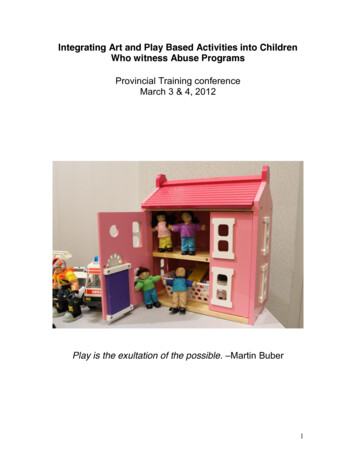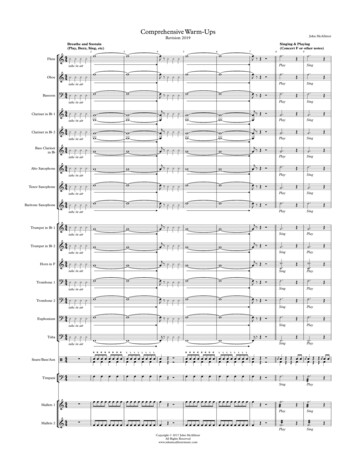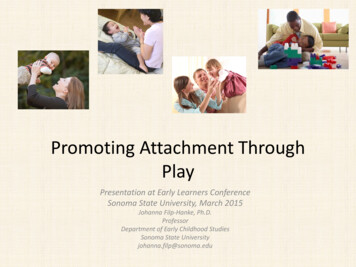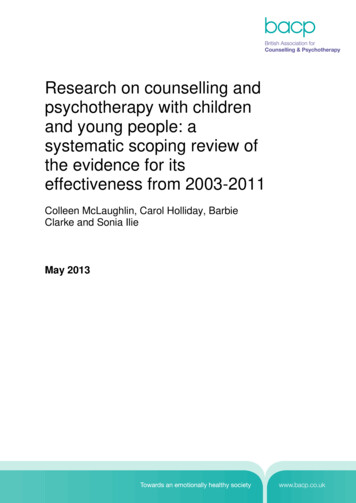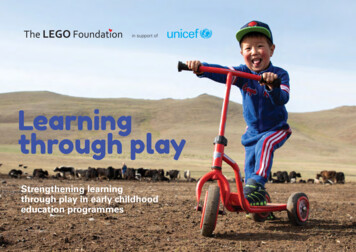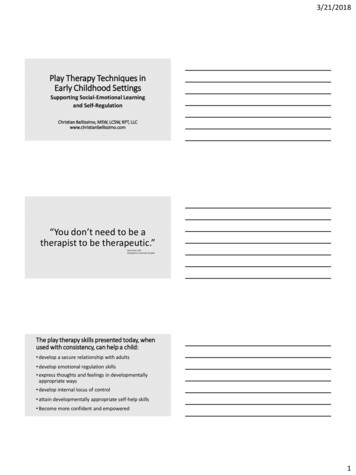
Transcription
3/21/2018Play Therapy Techniques inEarly Childhood SettingsSupporting Social-Emotional Learningand Self-RegulationChristian Bellissimo, MSW, LCSW, RPT, LLCwww.christianbellissimo.com“You don’t need to be atherapist to be therapeutic.”Neal Horen, MDGeorgetown University HospitalThe play therapy skills presented today, whenused with consistency, can help a child: develop a secure relationship with adults develop emotional regulation skills express thoughts and feelings in developmentallyappropriate ways develop internal locus of control attain developmentally appropriate self-help skills Become more confident and empowered1
3/21/2018OverviewThe impact of early adversity on young children.Play Therapy techniques for teachers to use in the earlychildhood classroom.The basics of brain developmentExecutiveFunction“What canI learnfrom this?”The Child’s Developing BrainADULTEmotionalRegulation“Am Iloved?Fight, flight,freeze“Am I safe?”BIRTH“Bottom-Up / Inside-Out”2
3/21/201880%By age 4, 80% of the brain’s structures responsible forfuture emotional, behavioral, social, and physiologicalfunctioning, are developed.Bruce Perry, MDwww.childtrauma.orgTrauma and ChildrenOne in fourchildren witness orexperience atraumatic eventbefore the age of 4,and more thantwo-thirds by age16.neaToday, Winter 20178Abuse and Neglect by Age: United States, 201547%www.acf.hhs.gov3
3/21/2018ACE Score and Developmental Delays at ThreeFrequency of DelaysNumber of -development/POLL4
3/21/2018Domestic ViolenceDomestic Violence5
3/21/2018Video 1Play Therapy and Early AdversityPlay in Preschool Children: What to Look ForSymbolic PlayGoal-directionEnjoyableFrustration tolerancePOLL6
3/21/2018Using play to support children’s emotional developmentThe parallels betweenPlay Therapyand Early Childhood“You don’t need to be a therapist to be therapeutic.”Opportunities to strengthenself-regulatory skillsEarly Adverse ExperiencesBuilding a senseof perceived controlSupportive adult-childrelationshipsBuilding Resilience using Play Therapy key-concepts/resilience/Using play to support children’s emotional developmentThe Environment“You don’t need to be a therapist to be therapeutic.”7
3/21/2018Play Therapy RoomEarly Childhood ClassroomUsing play to support children’s emotional developmentThe Relationship“You don’t need to be a therapist to be therapeutic.”8
3/21/2018The Principles of Child-Centered Play Therapy1. The therapist accepts the child exactly as her or sheis.2. The therapist must develop a warm, friendlyrelationship with the child, in which good rapport isestablished as soon as possible.Axline (1976). Play Therapy. Ballantine Books, New York, NYPlay Skill Number One:Build a RelationshipPlay Skill Number One:Build a RelationshipBody LanguageDown on the child’s levelOpen, relaxed postureMaintain arm’s length9
3/21/2018Play Skill Number One:Build a RelationshipBody Language: Benefits Helps build a rapport and supports attachment Actively addresses boundariesThe Principles of Child-Centered Play Therapy3. The therapist does not attempt to direct the child’sactions or conversation. The child leads, the therapistfollows.Axline (1976). Play Therapy. Ballantine Books, New York, NYPlay Skill Number Two:Allow the Child to Lead While Describing PlayAllow the child to self-initiate the play.Describe the child’s play while avoiding asking questions.10
3/21/2018Play Skill Number Two:Allow the Child to Lead and Describe PlayAllow the Child to Lead: Benefits Supports developmentally appropriate expression ofthoughts and feelingsDescribe the Child’s Play: Benefits “Attunement” Speech, language, and vocabulary modelingPlay Skill Number Two:Allow the Child to Lead While Describing PlayCooperative role play: What to doWhen a child invites you to participate in their play: Seek their direction. Ask what you should do or say.Video 2Allow the Child to Lead and Describe Play(Sea Animals)Seeking the Child’s Direction(Pretend Eating)11
3/21/2018The Principles of Child-Centered Play Therapy4. The therapist is alert torecognize the feelings thechild is expressing andreflects those feelings backto him in such a mannerthat he gains insight intohis behavior.Axline (1976). Play Therapy. Ballantine Books, New York, NYPlay Skill Number Three:Name the Child’s FeelingsWhile playing with the child, name the feelings the childexpresses verbally and non-verbally.Play Skill Number Three:Name the Child’s FeelingsName the Child’s Feelings: Benefits Child learns feelings vocabulary Child learns that feelings are experienced in the body Child learns to recognize feelings in self and others Co-regulation12
3/21/2018Video 3Name the Child’s Feelings(Body Language, Frustration, ID through Play)The Principles of Child-Centered Play Therapy5. The child is given theresponsibility to make choices.Axline (1976). Play Therapy. Ballantine Books, New York, NYPlay Skill Number Four:Frame the Child’s Play as a Choice or DecisionWhen the child selects an activity, or an item or action withinan activity, acknowledge their choices.13
3/21/2018Play Skill Number Four:Frame the Child’s Play as a Choice or DecisionBenefits Supports internal locus of control Facilitates free expression of thoughts and feelings Supports limit settingThe Principles of Child-Centered Play Therapy6. The therapist establishes limitations to make thechild aware of their responsibility in the relationship.Axline (1976). Play Therapy. Ballantine Books, New York, NYPlay Skill Number Five:Limit SettingWhen the child engages in aprohibited behavior, set a limitutilizing choice giving and anatural consequence.14
3/21/2018Play Skill Number Five:Limit SettingBenefits Limits provide safety and emotional security Supports internal locus of controlReduces power strugglesSupports problem solvingSupports self-regulationPlay Skill Number Five:Limit SettingProcedure Acknowledge the child’s motivation or feeling State the limitProvide an alternative (if necessary)State the consequencePraise the child’s choice to self-correct, or enforce the limitLandreth (1991). Play Therapy, The Art of the Relationship; Accelerated Development, Bristol, PAVideo 4Framing Behavior as a Choice, Limit Setting(Markers, Hand, Sand)15
3/21/2018Play Skill Number Five:Limit SettingTips Modulate voice and maintain proximity Allow the child to self-correct Avoid “we” and “ok?” Consequence should involve loss of toy being used orcurrent activity Follow through!Limit Setting Tip:Be preventative!Establish expectations and reinforceoften through specific praise.POLL16
3/21/2018The Principles of Child-Centered Play Therapy7. The therapist maintains a deep respect for the child’sability to solve their own problems if given theopportunity to do so.Axline (1976). Play Therapy. Ballantine Books, New York, NYPlay Skill Number Six:Support Independence and Self- Regulationthrough Challenging TasksWhen the child is presented with a challenging task: Name the child’s feeling (co-regulation) Return responsibility Acknowledge effort Help just enough Praise perseverancePlay Skill Number Six:Support Independence and Self- Regulationthrough Challenging TasksBenefits Builds frustration tolerance Lengthens attention span Supports problem solving Co-regulation Supports developmentally appropriate autonomy Empowering17
3/21/2018Video 5Support Independence and Self-Regulation through Challenging Tasks(Markers, Shoes, Tying)Christian Bellissimo, MSW, LCSW, RPT, LLCwww.christianbellissimo.com18
Play Skill Number One: Build a Relationship Body Language: Benefits Helps build a rapport and supports attachment Actively addresses boundaries The Principles of Child-Centered Play Therapy 3. The therapist does not attempt to direct the child’s actions or conversation. The child leads, the therapist follows. Axline (1976). Play Therapy.File Size: 751KB


